Fotios Logothetis
LUCES-MV: A Multi-View Dataset for Near-Field Point Light Source Photometric Stereo
Dec 21, 2024Abstract:The biggest improvements in Photometric Stereo (PS) field has recently come from adoption of differentiable volumetric rendering techniques such as NeRF or Neural SDF achieving impressive reconstruction error of 0.2mm on DiLiGenT-MV benchmark. However, while there are sizeable datasets for environment lit objects such as Digital Twin Catalogue (DTS), there are only several small Photometric Stereo datasets which often lack challenging objects (simple, smooth, untextured) and practical, small form factor (near-field) light setup. To address this, we propose LUCES-MV, the first real-world, multi-view dataset designed for near-field point light source photometric stereo. Our dataset includes 15 objects with diverse materials, each imaged under varying light conditions from an array of 15 LEDs positioned 30 to 40 centimeters from the camera center. To facilitate transparent end-to-end evaluation, our dataset provides not only ground truth normals and ground truth object meshes and poses but also light and camera calibration images. We evaluate state-of-the-art near-field photometric stereo algorithms, highlighting their strengths and limitations across different material and shape complexities. LUCES-MV dataset offers an important benchmark for developing more robust, accurate and scalable real-world Photometric Stereo based 3D reconstruction methods.
NPLMV-PS: Neural Point-Light Multi-View Photometric Stereo
May 20, 2024


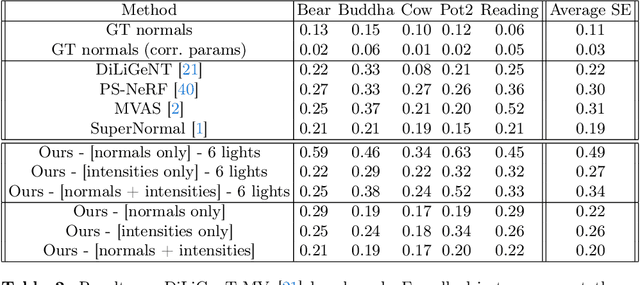
Abstract:In this work we present a novel multi-view photometric stereo (PS) method. Like many works in 3D reconstruction we are leveraging neural shape representations and learnt renderers. However, our work differs from the state-of-the-art multi-view PS methods such as PS-NeRF or SuperNormal we explicity leverage per-pixel intensity renderings rather than relying mainly on estimated normals. We model point light attenuation and explicitly raytrace cast shadows in order to best approximate each points incoming radiance. This is used as input to a fully neural material renderer that uses minimal prior assumptions and it is jointly optimised with the surface. Finally, estimated normal and segmentation maps can also incorporated in order to maximise the surface accuracy. Our method is among the first to outperform the classical approach of DiLiGenT-MV and achieves average 0.2mm Chamfer distance for objects imaged at approx 1.5m distance away with approximate 400x400 resolution. Moreover, we show robustness to poor normals in low light count scenario, achieving 0.27mm Chamfer distance when pixel rendering is used instead of estimated normals.
A Neural Height-Map Approach for the Binocular Photometric Stereo Problem
Nov 10, 2023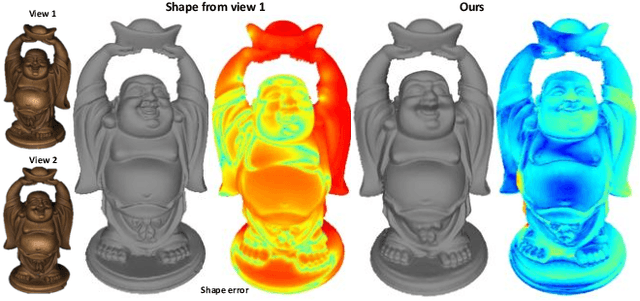

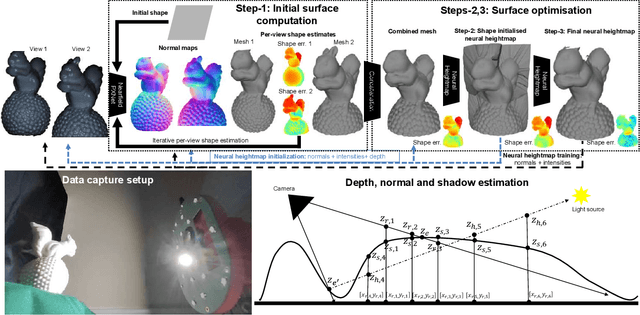

Abstract:In this work we propose a novel, highly practical, binocular photometric stereo (PS) framework, which has same acquisition speed as single view PS, however significantly improves the quality of the estimated geometry. As in recent neural multi-view shape estimation frameworks such as NeRF, SIREN and inverse graphics approaches to multi-view photometric stereo (e.g. PS-NeRF) we formulate shape estimation task as learning of a differentiable surface and texture representation by minimising surface normal discrepancy for normals estimated from multiple varying light images for two views as well as discrepancy between rendered surface intensity and observed images. Our method differs from typical multi-view shape estimation approaches in two key ways. First, our surface is represented not as a volume but as a neural heightmap where heights of points on a surface are computed by a deep neural network. Second, instead of predicting an average intensity as PS-NeRF or introducing lambertian material assumptions as Guo et al., we use a learnt BRDF and perform near-field per point intensity rendering. Our method achieves the state-of-the-art performance on the DiLiGenT-MV dataset adapted to binocular stereo setup as well as a new binocular photometric stereo dataset - LUCES-ST.
A CNN Based Approach for the Point-Light Photometric Stereo Problem
Oct 10, 2022Abstract:Reconstructing the 3D shape of an object using several images under different light sources is a very challenging task, especially when realistic assumptions such as light propagation and attenuation, perspective viewing geometry and specular light reflection are considered. Many of works tackling Photometric Stereo (PS) problems often relax most of the aforementioned assumptions. Especially they ignore specular reflection and global illumination effects. In this work, we propose a CNN-based approach capable of handling these realistic assumptions by leveraging recent improvements of deep neural networks for far-field Photometric Stereo and adapt them to the point light setup. We achieve this by employing an iterative procedure of point-light PS for shape estimation which has two main steps. Firstly we train a per-pixel CNN to predict surface normals from reflectance samples. Secondly, we compute the depth by integrating the normal field in order to iteratively estimate light directions and attenuation which is used to compensate the input images to compute reflectance samples for the next iteration. Our approach sigificantly outperforms the state-of-the-art on the DiLiGenT real world dataset. Furthermore, in order to measure the performance of our approach for near-field point-light source PS data, we introduce LUCES the first real-world 'dataset for near-fieLd point light soUrCe photomEtric Stereo' of 14 objects of different materials were the effects of point light sources and perspective viewing are a lot more significant. Our approach also outperforms the competition on this dataset as well. Data and test code are available at the project page.
LUCES: A Dataset for Near-Field Point Light Source Photometric Stereo
Apr 27, 2021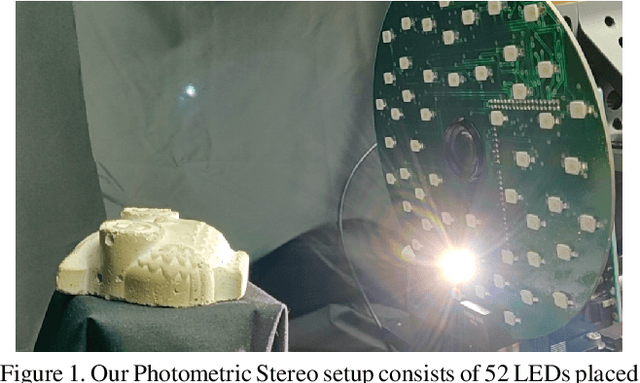
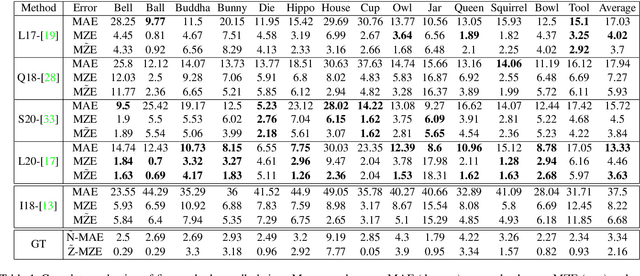

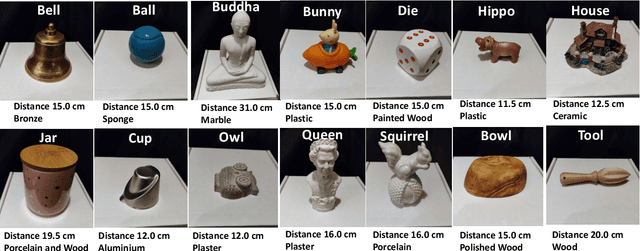
Abstract:Three-dimensional reconstruction of objects from shading information is a challenging task in computer vision. As most of the approaches facing the Photometric Stereo problem use simplified far-field assumptions, real-world scenarios have essentially more complex physical effects that need to be handled for accurately reconstructing the 3D shape. An increasing number of methods have been proposed to address the problem when point light sources are assumed to be nearby the target object. The proximity of the light sources complicates the modeling of the image formation as the light behaviour requires non-linear parameterisation to describe its propagation and attenuation. To understand the capability of the approaches dealing with this near-field scenario, the literature till now has used synthetically rendered photometric images or minimal and very customised real-world data. In order to fill the gap in evaluating near-field photometric stereo methods, we introduce LUCES the first real-world 'dataset for near-fieLd point light soUrCe photomEtric Stereo' of 14 objects of a varying of materials. A device counting 52 LEDs has been designed to lit each object positioned 10 to 30 centimeters away from the camera. Together with the raw images, in order to evaluate the 3D reconstructions, the dataset includes both normal and depth maps for comparing different features of the retrieved 3D geometry. Furthermore, we evaluate the performance of the latest near-field Photometric Stereo algorithms on the proposed dataset to assess the SOTA method with respect to actual close range effects and object materials.
A CNN Based Approach for the Near-Field Photometric Stereo Problem
Sep 12, 2020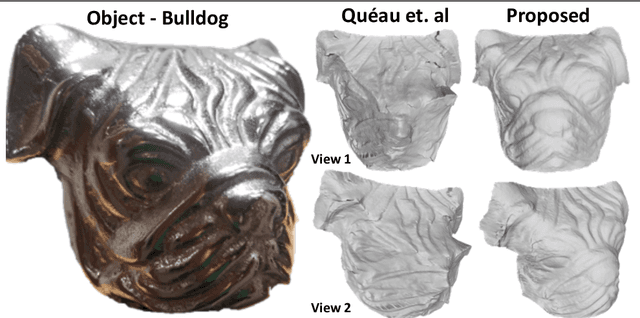
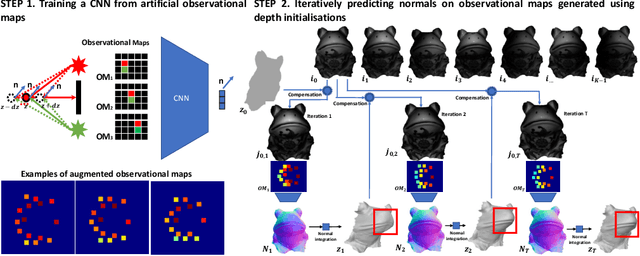


Abstract:Reconstructing the 3D shape of an object using several images under different light sources is a very challenging task, especially when realistic assumptions such as light propagation and attenuation, perspective viewing geometry and specular light reflection are considered. Many of works tackling Photometric Stereo (PS) problems often relax most of the aforementioned assumptions. Especially they ignore specular reflection and global illumination effects. In this work, we propose the first CNN based approach capable of handling these realistic assumptions in Photometric Stereo. We leverage recent improvements of deep neural networks for far-field Photometric Stereo and adapt them to near field setup. We achieve this by employing an iterative procedure for shape estimation which has two main steps. Firstly we train a per-pixel CNN to predict surface normals from reflectance samples. Secondly, we compute the depth by integrating the normal field in order to iteratively estimate light directions and attenuation which is used to compensate the input images to compute reflectance samples for the next iteration. To the best of our knowledge this is the first near-field framework which is able to accurately predict 3D shape from highly specular objects. Our method outperforms competing state-of-the-art near-field Photometric Stereo approaches on both synthetic and real experiments.
PX-NET: Simple, Efficient Pixel-Wise Training of Photometric Stereo Networks
Aug 11, 2020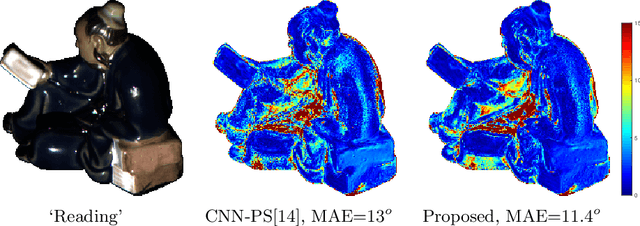

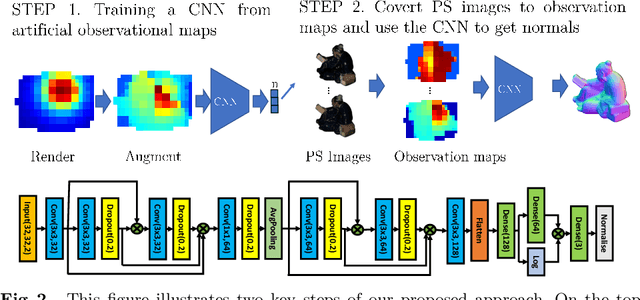
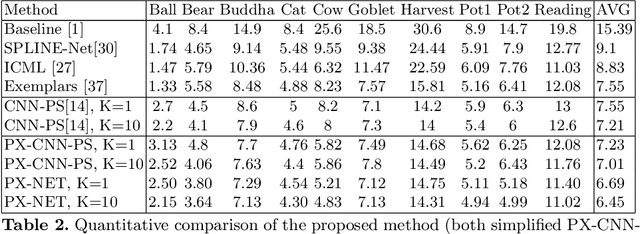
Abstract:Retrieving accurate 3D reconstructions of objects from the way they reflect light is a very challenging task in computer vision. Despite more than four decades since the definition of the Photometric Stereo problem, most of the literature has had limited success when global illumination effects such as cast shadows, self-reflections and ambient light come into play, especially for specular surfaces. Recent approaches have leveraged the power of deep learning in conjunction with computer graphics in order to cope with the need of a vast number of training data in order to invert the image irradiance equation and retrieve the geometry of the object. However, rendering global illumination effects is a slow process which can limit the amount of training data that can be generated. In this work we propose a novel pixel-wise training procedure for normal prediction by replacing the training data of globally rendered images with independent per-pixel renderings. We show that robustness to global physical effects can be achieved via data-augmentation which greatly simplifies and speeds up the data creation procedure. Our network, PX-NET, achieves the state-of-the-art performance on synthetic datasets, as well as the Diligent real dataset.
A Differential Volumetric Approach to Multi-View Photometric Stereo
Nov 05, 2018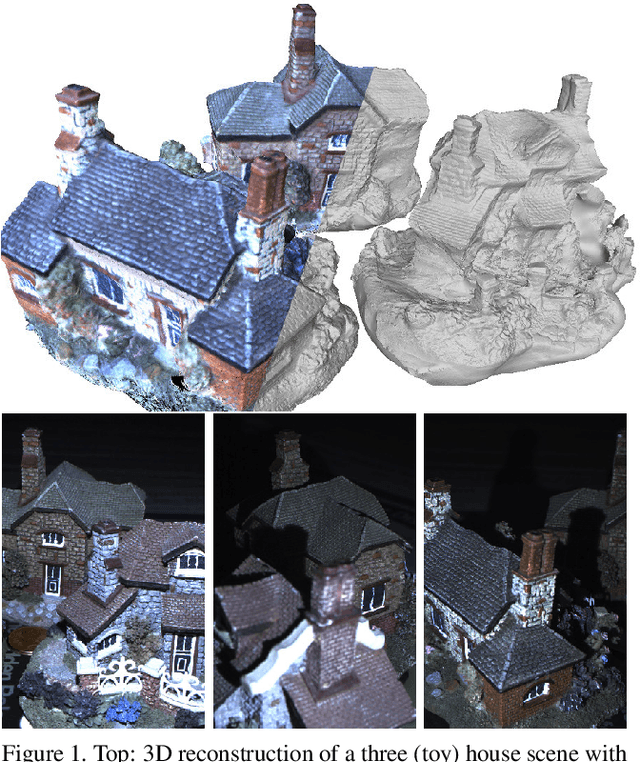

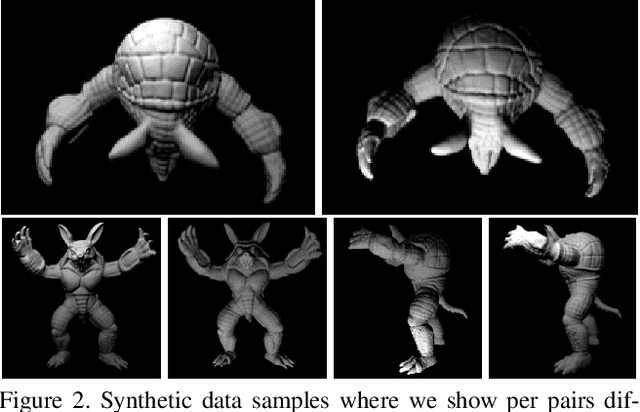
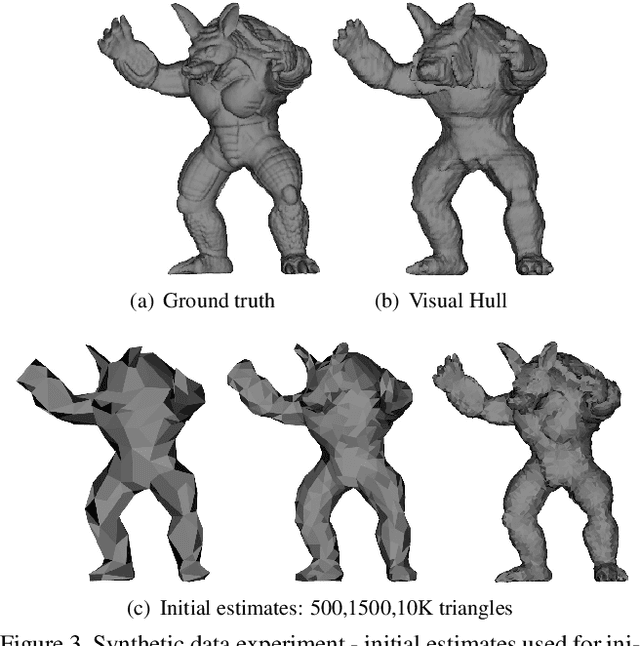
Abstract:Highly accurate 3D volumetric reconstruction is still an open research topic where the main difficulties are usually related to merging rough estimations with high frequency details. One of the most promising methods is the fusion between multi-view stereo and photometric imaging 3D shape reconstruction techniques. However, beside the intrinsic difficulties that multi-view stereo and photometric stereo have to make them working reliably, supplementary problems raise when considered together. Most importantly, the projection of the fine details usually retrievable with photometric stereo onto the rough multi-view stereo reconstruction is difficult to handle. In this work, we present a volumetric approach to the multi-view photometric stereo problem defined by a unified differential model. The key to our method is the signed distance field parameterisation which avoids the complex step of re-projecting high frequency details as the parameterisation of the whole volume allows a photometric modeling on the volume itself efficiently dealing with occlusions, discontinuities, etc. The relation between the surface normals and the gradient of the signed distance field leads to a homogeneous linear partial differential equation. A variational optimisation is adopted in order to combine multiple images from multiple points of view in a single system avoiding the need of merging depth maps. Our approach is evaluated on synthetic and real data-sets and achieves state-of-the-art results.
 Add to Chrome
Add to Chrome Add to Firefox
Add to Firefox Add to Edge
Add to Edge